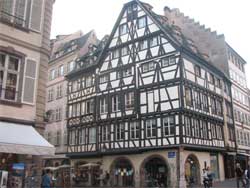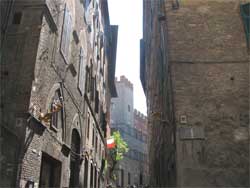Medieval Towns
During the first centuries of the Middle Ages, towns were more numerous than important, poor and with a small population. The lack of roads security hampered the development of the medieval towns, which in turn prevented the development of commerce. Except for a short revival during Charlemagne's reign, the commerce was reduced to simply exchanging the necessities of life. Each domain had to be almost self-sufficient, producing the necessary iron, wood, wool and wheat. And, without commerce there can be no large cities.
The medieval towns occupied, to some extent, the sites of previous Roman colonies and municipia, while new ones emerged in the vicinity of a castle or a monastery. The revival of production and commerce taking place between the 10th and the 13th century led to a considerable increase of the population and wealth of the medieval towns, and they reached their glorious days in the second half of the 14th century.
Medieval towns layout
The medieval towns were surrounded by a moat and walls made of stone or brick. The walls had towers, round or square, designed both for defense and as a decoration. Nuremberg for example had more than eighty. Access in town was permitted only through the vaulted access gates which were closed at night.
The medieval towns usually grew up around a castle or monastery, or followed the contour of a hillside, or a river-bank. As a result, they had steep, meandering streets, with irregular width. As the land available within the walls of the medieval towns was limited, the streets were narrow. The main streets ran to the city gates, which were the only points of access in and out of town.

Northern Medieval City: Strasbourg, France
The picturesque but crowded streets were full of obstacles preventing a comfortable movement across town, and primitive urban development regulations were put in place. One of them required that the town centre should have at least one clear street, such as a horseman with a lance across his saddle could ride without being obstructed by anything in his path. If any part of a building interfered with the lance, it had to be demolished.
Houses in the medieval towns reflected the rank of those living in them. The houses of the high ranking persons could look like small fortresses, while those of ordinary people resembled the houses of the peasants, having a courtyard and granaries. Due to the increasing price of land within the city walls, houses several stories high had each story extended beyond the one beneath. Many houses were built of wood and the peaked roof was ornamented by a gable, or a turret.
In the Southern medieval towns, houses could have balconies, while in the North, as in Germany, these were replaced by the "erker", an alcove which from outside looked like an ornamented, covered balcony.
Town guilds
The revival of the medieval cities was assisted by the evolution of the guilds. By the second half of the 12th century, the guilds, or corporations, were already completely organized in France and Italy and were in existence in Germany and England, where they will attain a similar level of organization in the next century. The members of the corporations worked on their own account and sold their products on the market.

A Medieval city street: Siena, Italy
Within the medieval towns, the organization of guilds was facilitated by the fact that people of the same occupation were gathered into the same street. There was a "Tanners street," a "Saddlers street," etc. Each trade had its common coffer, its banner, it had its patron saint (the carpenters had Saint Joseph, the shoemakers Saint Crispin), it had its own regulations. These regulations specified the conditions upon which a person could be admitted into the trade, who can vote in the assembly of the trades, etc. They were also meant to guard the honor of the guild by not permitting any but honestly made merchandise to be sold.
Town law and government
The medieval towns could be self-governing and could have a court of their own. As a result, they had their own customs, their own set of penalties for offences, their particular methods of court procedure, and their local legislation and ordinances.
The cities of the Middle Ages had a considerable influence upon the development of European law, first through their local customs and second through the growth of the law merchant in the Mediterranean cities.
Today, you can get a feeling on how life was in the medieval towns, by visiting places like San Gimignano in Italy, Dinan and Biot in France, or Rothenburg ob der Tauber in Germany, which are still preserving their medieval atmosphere and charm.
More on Town Life in the Middle Ages.
